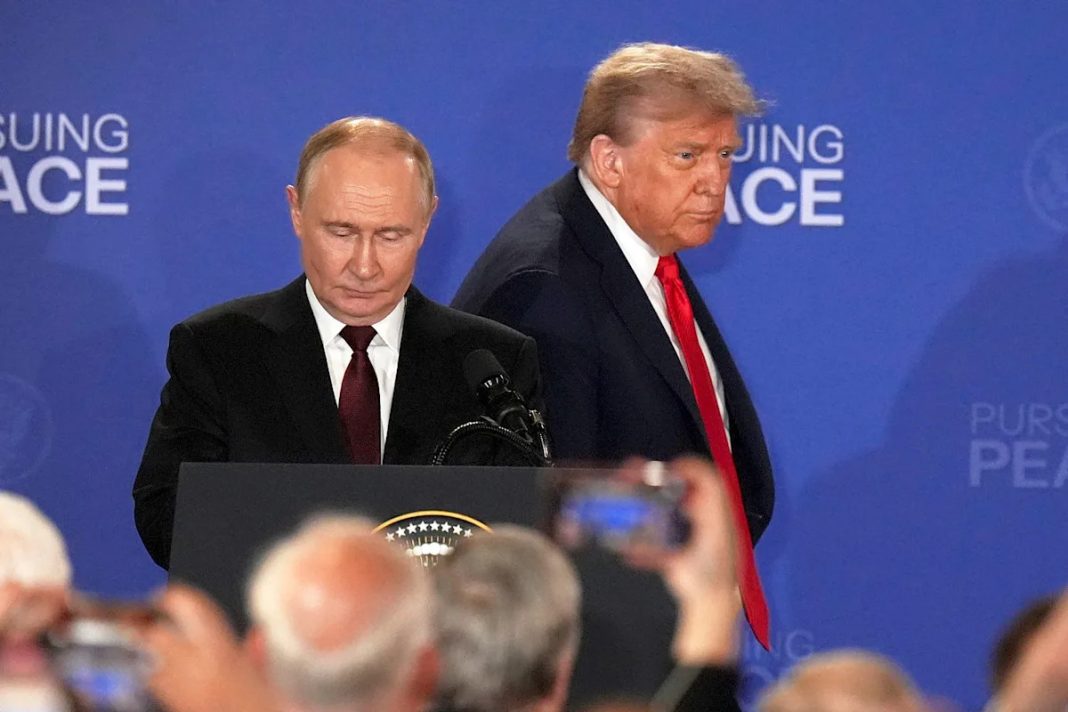President Donald Trump flew to Alaska hoping he could pull a diplomatic rabbit out of his hat. Although he kept his expectations low and described the high-stakes summit with Russian President Vladimir Putin as a way to determine whether Moscow was committed to participating in a serious peace process to end the war in Ukraine, it was clear from the get-go that Trump wanted to leave the meeting with some kind of ceasefire in hand. “I won’t be happy if I walk away without some form of a ceasefire,” Trump told Fox News’ Bret Baier.
If those were Trump’s true feelings, then he must have been sulking on Air Force One as he headed back to Washington, D.C. Trump not only failed to get the immediate, unconditional ceasefire he was pining for, but he also got bludgeoned by foreign policy commentators who faulted him for gifting Putin international legitimacy for nothing in return. Trump sounded downright solemn during his 12-minute “press conference” with Putin, admitting straight away that while unidentified progress was made, there wasn’t enough common ground to hash out even a rough, preliminary outline of a deal. “We had an extremely productive meeting, and many points were agreed to,” Trump asserted. “There are just a very few that are left. Some are not that significant. One is probably the most significant, but we have a very good chance of getting there.”
It doesn’t take a genius in international affairs to understand that “the most significant” item he was referring to was the one issue that prompted him to organize a summit with Putin in the first place: the war in Ukraine.
None of this should be shocking to anybody who has been monitoring the 3 1/2-year conflict. Trump may have an inherently oversized opinion of his capacity to will peace deals into existence, but on Ukraine at least, he’s not the most important person in the story. That honor goes to Putin and Ukrainian President Volodymyr Zelenskyy, two men who not only have a visceral hatred toward each other but more importantly a set of goals that are as close to irreconcilable as you can get.
Trump believed he could use his hours with Putin as an opportunity, if not to move Putin closer to middle ground, then at least to begin a high-level diplomatic process that would get Putin into the same room with the Ukrainian leader. Despite the hyperventilation surrounding the Alaska meeting, Trump wasn’t wrong to extend an invitation to Putin to determine whether a path forward existed; this isn’t the first time a U.S. president has shaken hands with a despot, and it won’t be the last.
Trump greeting Putin on a tacky red carpet wasn’t the problem. Rather, the problem is that Putin remains committed to fighting, still believes he can achieve more by continuing the war than he can through negotiations and has prioritized success in Ukraine over everything else — including an improvement in U.S.-Russia relations.
Unfortunately for everybody who wants the war to end in a diplomatic settlement, Putin doesn’t have much of an incentive to sign up to anything when the battlefield has shifted in Moscow’s favor. Although Russian troops continue to die at an astounding rate, the Russian army has made more territorial gains over the last week than it has in months. One can’t say the same about the Ukrainian army, whose manpower issues are getting more serious as the war persists and whose population is increasingly supportive of a deal that ends the war over slugging it out until victory. The Ukrainians may not want to cede a chunk of their country to the Russians, but neither do they want to continue a war that is exhausting the country economically, socially and demographically.
Like all wars in human history, the facts on the ground, not any individual’s dealmaking abilities, will determine when the war ends and what type of settlement is reached. And for any settlement to stick, the combatants must both come to the conclusion that a good-enough peace is preferable to more war. Right now, those elements aren’t available. Look no further than Friday, when Putin reportedly told Trump that he would sign up to a ceasefire and freeze the current battle lines in Zaporizhzhia and Kherson if Ukrainian forces withdrew from the entire Donbas region, 30% of which the Ukrainian army still controls. It’s a proposal Zelenskyy is bound to reject, and Putin knows it.
The question now is what Trump will do going forward. There are several options on the table. One is to simply persist on the diplomatic front, hoping that with the passage of time and enough creativity, Putin and Zelenskyy will eventually get to yes. Zelenskyy and a group of European leaders will meet with Trump at the White House on Monday for a full debriefing of what Trump and Putin talked about in Alaska, and it’s likely the Trump administration will try to entice both sides of the conflict to participate in a bilateral summit to keep the process moving.
The second option would be to double down on the Biden administration’s own policy, which consisted of sanctions on the Russian economy and providing ending supplies of military equipment to the Ukrainian army with the presumption that Putin would, over time, sue for peace on Kyiv’s terms. That policy killed a lot of Russians and allowed the Ukrainians to hold their own on the battlefield but failed to move Putin in the direction Washington sought. If anything, the more the United States became involved, the more resources Putin committed to his own war strategy. Why would Trump give this failed strategy a second chance?
A third option, and the least painless one for the United States, would be to hand over the Ukraine file completely to the Europeans, who have a greater stake in the endgame than Washington does. European governments are already stepping up in a big way for Ukraine, both in terms of the financial assistance they are providing to Kyiv as well as military aid they are willing to give. Washington is already moving in this direction; in July, Trump agreed to sell U.S. weapons to Europe and allow those weapons to be transferred to the Ukrainian army.
Regardless of which policy the United States settles on, the summit in Alaska demonstrates yet again that it’s Putin and Zelenskyy driving this train, not Trump.
This article was originally published on MSNBC.com

